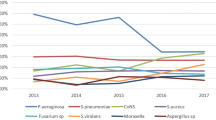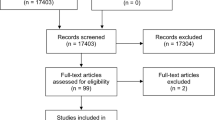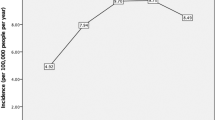Abstract
Background
To identify the current bacterial spectrum, the specific resistances to commonly used antibiotics, and the predisposing risk factors causing bacterial keratitis.
Methods
We reviewed the microbiological results of corneal scrapes and predisposing risk factors from 346 patients with bacterial keratitis. Infectious bacteria was isolated from corneal samples and sensitivity testing was subsequently performed.
Results
In total, 346 samples were obtained from 174 female and 172 male patients (median age: 64 years; range 5–105 years). A positive culture was obtained in 43% (148/346), recovering 199 isolates. Staphylococcus aureus was the most frequently occurring Gram-positive strain (32%) and Pseudomonas aeruginosa was the predominant Gram-negative strain (10%). Patients with specific local and systemic predisposing factors had an elevated risk for bacterial keratitis with a specific risk for certain strains. The sensitivity testing revealed that chloramphenicol and fusidic acid were the most effective monotherapy drugs, with overall resistances of 0 and 12%, respectively, followed by ciprofloxacin (22%), tobramycin (23%), and levofloxacin (24%).
Conclusions
The bacterial spectrum is changing. The most effective drugs are chloramphenicol and fusidic acid, followed by ciprofloxacin. Specific systemic and local predisposing factors promote the risk of bacterial keratitis.


Similar content being viewed by others
References
Hall RC, McKellar MJ (2004) Bacterial keratitis in Christchurch, New Zealand, 1997–2001. Clin Experiment Ophthalmol 32:478–481
Wang AG, Wu CC, Liu JH (1998) Bacterial corneal ulcer: a multivariate study. Ophthalmologica 212:126–132
Ormerod LD (1987) Causation and management of microbial keratitis in subtropical Africa. Ophthalmology 94:1662–1668
Carmichael TR, Wolpert M, Koornhof HJ (1985) Corneal ulceration at an urban African hospital. Br J Ophthalmol 69:920–926
Green M, Apel A, Stapleton F (2008) A longitudinal study of trends in keratitis in Australia. Cornea 27:33–39
Barry AL, Garcia F, Thrupp LD (1970) An improved single-disk method for testing the antibiotic susceptibility of rapidly-growing pathogens. Am J Clin Pathol 53:149–158
Sax CM, Piatigorsky J (1994) Expression of the alpha-crystallin/small heat-shock protein/molecular chaperone genes in the lens and other tissues. Adv Enzymol Relat Areas Mol Biol 69:155–201
Lam DS, Houang E, Fan DS, Lyon D, Seal D, Wong E, Hong Kong Microbial Keratitis Study Group (2002) Incidence and risk factors for microbial keratitis in Hong Kong: comparison with Europe and North America. Eye 16:608–618
Schaefer F, Bruttin O, Zografos L, Guex-Crosier Y (2001) Bacterial keratitis: a prospective clinical and microbiological study. Br J Ophthalmol 85:842–847
Morlet N, Minassian D, Butcher J (1999) Risk factors for treatment outcome of suspected microbial keratitis. Ofloxacin Study Group. Br J Ophthalmol 83:1027–1031
Gudmundsson OG, Ormerod LD, Kenyon KR, Glynn RJ, Baker AS, Haaf J, Lubars S, Abelson MB, Boruchoff SA, Foster CS (1989) Factors influencing predilection and outcome in bacterial keratitis. Cornea 8:115–121
Wong T, Ormonde S, Gamble G, McGhee CN (2003) Severe infective keratitis leading to hospital admission in New Zealand. Br J Ophthalmol 87:1103–1108
Sousa SJ, Dias VG, Marcomini LA (2008) Bilateral Acanthamoeba ulcer in a user of disposable soft contact lenses: a tragic incident or a consequence of the aggressive policy of soft contact lens trading? Arq Bras Oftalmol 71:430–433
Ibrahim YW, Boase DL, Cree IA (2009) Epidemiological characteristics, predisposing factors and microbiological profiles of infectious corneal ulcers: the Portsmouth Corneal Ulcer Study. Br J Ophthalmol 93:1319–1324
Neumaier-Ammerer B, Stolba U, Binder S, Feichtinger H (2004) Corneal infiltrates and ulcers. A retrospective study of 239 eyes. Ophthalmologe 101:33–38
Ormerod LD, Hertzmark E, Gomez DS, Stabiner RG, Schanzlin DJ, Smith RE (1987) Epidemiology of microbial keratitis in southern California. A multivariate analysis. Ophthalmology 94:1322–1333
McClellan KA, Bernard PJ, Billson FA (1989) Microbial investigations in keratitis at the Sydney Eye Hospital. Aust N Z J Ophthalmol 17:413–416
Schierholz JM, Beuth J (2001) Implant infections: a haven for opportunistic bacteria. J Hosp Infect 49:87–93
Inokari A, Misawa N (1997) Normal bacterial flora in human. Rinsho Byori 105:59–64
Author information
Authors and Affiliations
Corresponding author
Electronic supplementary material
Below is the link to the electronic supplementary material.
ESM 1
(DOC 28 kb)
Rights and permissions
About this article
Cite this article
Prokosch, V., Gatzioufas, Z., Thanos, S. et al. Microbiological findings and predisposing risk factors in corneal ulcers. Graefes Arch Clin Exp Ophthalmol 250, 369–374 (2012). https://doi.org/10.1007/s00417-011-1722-9
Received:
Revised:
Accepted:
Published:
Issue Date:
DOI: https://doi.org/10.1007/s00417-011-1722-9




